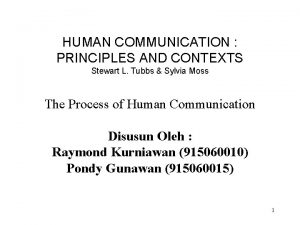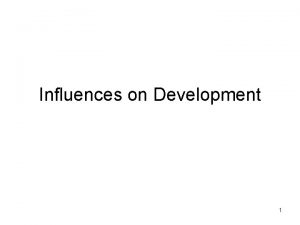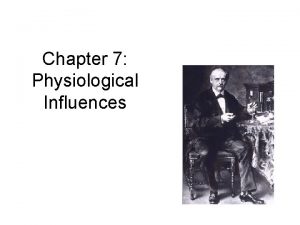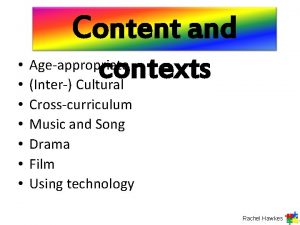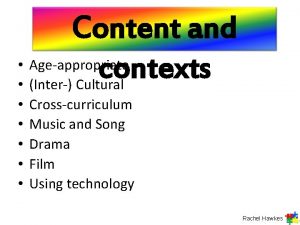Chapter 6 Cultural Influences on Contexts Cultural Influences


































- Slides: 34

Chapter 6 Cultural Influences on Contexts

Cultural Influences on Context • By nature all men are alike, but by education widely different. —Chinese Saying • Live together like brothers and do business like strangers. —Arab Proverb • If you are not in tune with the universe, there is sickness in the heart and mind. —Navajo Saying Chapter 6 Cultural Influences on Contexts

Learning Objectives • perceive the relationship between culture and context • perceive the relationship between communication and context • understand the different attitudes and conversational structures of health care context • summarize the different roles and behavioral patterns of educational context • evaluate the different management concept and behavioral modes of business context Chapter 6 Cultural Influences on Contexts

Case 1 A Refusal of an Offer of Coffee • Why did a refusal of coffee lead to the deadlock in the negotiations? Chapter 6 Cultural Influences on Contexts

Cultural Influences on Contexts A Understanding Context B The Health Care Context C The Educational Context D The Business Context E Intercultural Negotiations Chapter 6 Cultural Influences on Contexts

While-Class Learning: Text A • Pre-reading Questions What kinds of behaviors can be appropriate in the following contexts. Chapter 6 Cultural Influences on Contexts

Text A: Understanding Context • communication context: cultural, social, and physical settings • “frame (reference point)” : what specific actions should mean what behaviors are to be expected how to act appropriately and effectively • Internalized cultural rules Chapter 6 Cultural Influences on Contexts

Text A • Understanding Context Three basic assumptions about human communication: 1. Communication is rule governed 2. Context specifies communication rules 3. Communication rules are culturally diverse Chapter 6 Cultural Influences on Contexts

1. Communication is rule governed • Communication rules prescribe proper behavior • Social settings stipulate rules • Culture makes the rules • Rules cover both verbal and nonverbal behaviors • Rules specify what should be said, how it should be said Chapter 6 Cultural Influences on Contexts

2. Context specifies communication rules Diverse contexts, Different communication rules Chapter 6 Cultural Influences on Contexts

3. Communication rules are culturally diverse Different cultures, different rules. • Dress • Time • Language • Manners • Nonverbal behavior • Control of communication Chapter 6 Cultural Influences on Contexts

While-Class Learning: Text B • Pre-reading Activity 1. Recall your last visit to a doctor. 2. Identify the typical features in the Chinese medical context. Chapter 6 Cultural Influences on Contexts

While-Class Learning: Text B • The Health Care Context 1. Culture’s influence on the health care context 2. Family roles in the health care context 3. Conversational structures and language Chapter 6 Cultural Influences on Contexts

1. Culture’s influence on the health care context • Three basic health belief systems Biomedical System Personalistic System Naturalistic System Chapter 6 Cultural Influences on Contexts

a. Biomedical System • • Objective diagnosis Scientific explanation of disease Illness: abnormalities in functioning or structure Treatment destroy/remove causative agent repair affected body part control affected body system European American cultures Chapter 6 Cultural Influences on Contexts

b. Personalistic System • Health and illness: linked to supernatural forces • Disease: result of active intervention by supernatural being, nonhuman being, or human • Treatment: sooth/remove problematic supernatural forces Some African, many Asian cultures, Latino and African American cultures Chapter 6 Cultural Influences on Contexts

c. Naturalistic System • Health and illness: result of impersonal forces or conditions, an upset in balance of body elements • Disease: result from disequilibria • Treatment: restore balance The ancient Chinese principle of yin and yang Chapter 6 Cultural Influences on Contexts

2. Family roles in the health care context • Guidelines: how to perceive and communicate a. dominance patterns the United States: individual patient collectivist cultures: family members b. modesty (bodily displays for women) Latina women: not permitted to undress for an examination by male physicians/nurses Arab women: shy about disrobing for examinations Chapter 6 Cultural Influences on Contexts

3. Conversational structures and language • Latinos and Arabs: extensive small talk • Native Americans: extensive periods of silence • Asians and Asian Americans: indirection or other face-saving strategies • Individualistic and low-context cultures: important to communicate verbally • Collectivistic and high-context cultures: avoid conversing with physicians during medical interviews Chapter 6 Cultural Influences on Contexts

While-Class Learning: Text C • The Educational Context 1. Culture’s influence on the educational context 2. Classroom interaction a. role behaviors in class b. classroom discussion and participation Chapter 6 Cultural Influences on Contexts

While-Class Learning: Text D • The Business Context 1. Cultural views toward management a. North American b. European c. Asian d. Latin Chapter 6 Cultural Influences on Contexts

1. a. North American Management Styles • • • resent interference strong work ethic friendly and informal competitive and aggressive manager: a high status, a cultural hero Chapter 6 Cultural Influences on Contexts

1. b. European Management Styles • Germany: 1) detailed information and instruction to guide 2) do not need to motivate 3) authoritarian leadership style • France: 1) rules, regulations, and principles 2) authoritarian 3) autocratic • Britain: 1) diplomatic, tactful, laid back, casual, reasonable, helpful 2) compromise, fair 3) friendly small talk, casual approach to work Chapter 6 Cultural Influences on Contexts

1. c. Asian Management Styles • China: 1) harmony 2) kinship, interpersonal connections, face, and power 3) seniority: main source of power, from age and length of service • Japan: 1) harmonious integration of all members 2) organization: a large extended family 3) acceptance of hierarchy, sense of obligation, consensual decision making Chapter 6 Cultural Influences on Contexts

Cultural Views Toward Management Diverse Cultures North American European German Management Styles French British Asian Chinese Japanese Latino Mexican and Latin American Chapter 6 Cultural Influences on Contexts

While-Class Learning: Text D • The Business Context 2. Business Protocol a. initial contacts b. greeting behaviors c. gift giving Chapter 6 Cultural Influences on Contexts

a. Initial Contacts • American: 1) socialization is unimportant 2) not interested in long-term relationships 3) trust in counterparts • Chinese: 1) establish contacts 2) socializing is integral 3) long-term business or personal relationships Chapter 6 Cultural Influences on Contexts

b. Greeting Behaviors • American: 1) informal and friendly 2) shaking hands 3) first names used, except senior persons or formal situations 4) business cards exchanged in business settings • Chinese: 1) slight bow and brief shake of hands 2) social status and rank highly honored 3) business cards 4) family name Chapter 6 Cultural Influences on Contexts

c. Gift Giving • American: 1) akin to bribery 2) letters of thanks 3) a small token: flowers, a plant, or a bottle of wine • Japanese: 1) very common 2) do not open gifts 3) flowers, cakes, or candy when visiting Chapter 6 Cultural Influences on Contexts

While-Class Learning: Text E • Intercultural Negotiations 1. Pacing 2. Negotiation Styles 3. Variations in Decision-making Chapter 6 Cultural Influences on Contexts

1. Pacing America Latin America business lightning speed conducted much slower pace contracts signed common during the first meeting several trips to accomplish decisions made middle managers several people Some cultures: Personal relationships take priority over the product or service, business does not begin until friendships are established. Chapter 6 Cultural Influences on Contexts

2. Negotiation Styles Negotiation styles Americans Efficiency, directness; ready to bargain or compromise; logical arguments British Similar to Americans, but more silence, interrupt less; friendly, sociable, flexible French Most difficult of Europeans; long-winded; relish debate, confrontational and competitive Not compromise; clear, firm and assertive; frequently interrupt Germans Japanese Long pauses, silence; harmony Chinese Avoid conflict; long-term relationships; facesaving; status; indirect, silence; smile Chapter 6 Cultural Influences on Contexts

3. Variations in Decision-making Variations in decision-making Americans Problem solvers; rational thinking and concrete data, factual inductive French Debate; conservative, safe decision-makers; decisions made by top authorities Japanese Level expertise; consensus-building process Chinese More authoritative than consensual; Chapter 6 Cultural Influences on Contexts

Thank You Chapter 6 Cultural Influences on Contexts
 Professional context examples
Professional context examples Writing in academic contexts
Writing in academic contexts Teachers in crisis contexts
Teachers in crisis contexts What sociological perspective stresses that age
What sociological perspective stresses that age Characteristics of bad srs document
Characteristics of bad srs document Personal and cultural expression global context
Personal and cultural expression global context Intercultural communication in contexts
Intercultural communication in contexts Shape matching and object recognition using shape contexts
Shape matching and object recognition using shape contexts Model tubbs
Model tubbs Template matching
Template matching Example of cultural influences
Example of cultural influences Example of cultural influences
Example of cultural influences What cultural influences shaped the byzantines?
What cultural influences shaped the byzantines? Bob fosse influences
Bob fosse influences Major influences on business buyers
Major influences on business buyers Pop art self portrait
Pop art self portrait Normative age-graded
Normative age-graded Internal influences on a business
Internal influences on a business Environmental influences
Environmental influences Factors for communication
Factors for communication Latitude strongly influences climate because
Latitude strongly influences climate because Environmental influences
Environmental influences Anything that surrounds us is known as
Anything that surrounds us is known as Normative age graded influences
Normative age graded influences Social influences on consumer behavior
Social influences on consumer behavior Annie leibovitz influences
Annie leibovitz influences Analyzing influences definition
Analyzing influences definition Which of the following is a pronatalist pressure?
Which of the following is a pronatalist pressure? French table setting
French table setting Advantages of media influence on parliament
Advantages of media influence on parliament Influences on parliamentary law making
Influences on parliamentary law making Salty sour
Salty sour Mary shelley influences
Mary shelley influences My system of career influences
My system of career influences Environmental influences on consumer behavior
Environmental influences on consumer behavior








